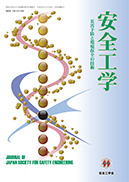
- Issue 6 Pages 01-
- Issue 5 Pages 01-
- Issue 4 Pages 01-
- Issue 3 Pages 01-
- Issue 2 Pages 01-
- Issue 1 Pages 01-
- |<
- <
- 1
- >
- >|
-
2022 Volume 61 Issue 3 Pages 01-04
Published: June 15, 2022
Released on J-STAGE: June 15, 2022
JOURNAL RESTRICTED ACCESSDownload PDF (650K)
-
Junichi Nakamura2022 Volume 61 Issue 3 Pages 167
Published: June 15, 2022
Released on J-STAGE: June 15, 2022
JOURNAL RESTRICTED ACCESSDownload PDF (608K)
-
Ryoji MakinoArticle type: review-article
2022 Volume 61 Issue 3 Pages 168-176
Published: June 15, 2022
Released on J-STAGE: June 15, 2022
JOURNAL RESTRICTED ACCESS -
Taiji Sugimoto, Tetsu Moriyama, Takabumi FukudaArticle type: review-article
2022 Volume 61 Issue 3 Pages 177-185
Published: June 15, 2022
Released on J-STAGE: June 15, 2022
JOURNAL RESTRICTED ACCESS -
For Co-creating the Better Technological SocietyHiroyuki SeyazakiArticle type: review-article
2022 Volume 61 Issue 3 Pages 186-192
Published: June 15, 2022
Released on J-STAGE: June 15, 2022
JOURNAL RESTRICTED ACCESS
-
Tomohiko Imamura, Jun-ichi Suematsu, Hiroya Yanagi2022 Volume 61 Issue 3 Pages 193-200
Published: June 15, 2022
Released on J-STAGE: June 15, 2022
JOURNAL FREE ACCESSThe quenching distance of premixed propane/air mixture flowing comparatively slow velocity was experimentally investigated to contribute the accurate evaluation for physical hazard of flammable gases. The quenching distance decreased with increasing flow velocity with in the present range of flow velocity. It was because the heat loss of flame core decreased as the residential duration of flame core within the gap of electrode flat plate was shortened by forced flow. When the quenching distance in the presence of forced flow was normalized by which in the absence of forced flow, it could be arranged well by the normalized flame propagation rate which was the ratio of the dimensional flame propagation rate in the presence of forced flow to that in the absence of forced flow regardless of the flow velocity. The laminar burning velocity which was required to estimate the normalized flame propagation rate as mentioned above could be estimated by Cantera with USC-Mech reaction mechanism model. As these results, the quenching distance of flowing propane/air mixture with comparatively slow velocity is resulted to be underestimate evaluation from the quenching distance in the absence of forced flow. However, if the relationship between the quenching distance and the flame propagation rate in the absence of forced flow can be estimated well, that in the presence of forced flow can also be estimated well by the above relationship between normalized quenching distance and normalized flame propagation rate. It is the greatest finding obtained in the present work.
View full abstractDownload PDF (2530K) -
Teruhito Otsuka, Satoru Mochida, Takashi Furuya2022 Volume 61 Issue 3 Pages 201-208
Published: June 15, 2022
Released on J-STAGE: June 15, 2022
JOURNAL FREE ACCESSIn the previous paper, authors proposed a method to associate the degree of explosive atmosphere formation with the downtime of protective measures related to dilution and ventilation. In this paper, based on the concept of downtime, the correspondence with grade of release by considering the release suppression protection measures are examined. Under high dilution condition, when the availability of ventilation is fair, and grade of release is continuous, it is judged to be zone 2. There is a difference of more than 100 times between the continuous and the secondary grade of release. Therefore, the situation, where it is interpreted as a Negligible Extent would be less than 1/100 of the existence time of the explosive atmosphere in Zone 2 for 10 hours in a year with fair availability of ventilation and secondary grade of release. As a result, it was found that the area at where the annual existence time of the explosive atmosphere is less than 0.1 hour, should be considered as non classified for the consistency with the classification table of IEC. Since it is not a realistic to achieve this criterion with dilution protection measures alone, a combination of release suppression and dilution protection measures was proposed to reduce the time of explosive atmosphere presence and to acquire of non-hazardous area in a realistic manner. It was also shown that the reduction rate at this time agreed with the risk mitigation coefficient indicated by IEC TS 60079-42. The level of functional safety required for interlocks was discussed by comparing the combination of interlocks and dilution protection measures.
View full abstractDownload PDF (1255K)
-
Tomoya Soma2022 Volume 61 Issue 3 Pages 209-211
Published: June 15, 2022
Released on J-STAGE: June 15, 2022
JOURNAL RESTRICTED ACCESS
-
Shinichirou Gotou2022 Volume 61 Issue 3 Pages 212-216
Published: June 15, 2022
Released on J-STAGE: June 15, 2022
JOURNAL RESTRICTED ACCESSDownload PDF (4163K)
-
[in Japanese], [in Japanese], [in Japanese], [in Japanese]2022 Volume 61 Issue 3 Pages 217-221
Published: June 15, 2022
Released on J-STAGE: June 15, 2022
JOURNAL RESTRICTED ACCESSDownload PDF (725K)
-
Shuichi Munakata2022 Volume 61 Issue 3 Pages 222-223
Published: June 15, 2022
Released on J-STAGE: June 15, 2022
JOURNAL RESTRICTED ACCESSDownload PDF (591K)
-
2022 Volume 61 Issue 3 Pages 224-225
Published: June 15, 2022
Released on J-STAGE: June 15, 2022
JOURNAL RESTRICTED ACCESSDownload PDF (817K)
- |<
- <
- 1
- >
- >|